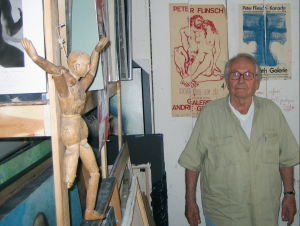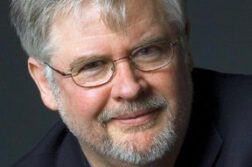FOR PETER FLINSCH, it was simply an innocent kiss. It happened at a Christmas party in 1942, when he, then in the German army, was celebrating with other members of the military. At the end of the evening, the 22-year-old officer embraced another soldier, and the two exchanged a friendly, boozy kiss.
That moment would forever alter the life of Flinsch, who died in his sleep at his downtown Montreal apartment on March 30 of natural causes. “It was a friendly kiss, but it was at the wrong time, in the wrong place, that caused it all,” Flinsch told me in 2008, when I was profiling him for The Advocate. Everything changed for him because another officer witnessed the embrace and locking of lips—and that led to charges of homosexuality, which under German law of the time meant several years in prison. Flinsch was demoted and sentenced to three years in a Nazi work camp, where he was forced to publicly announce the reason for his imprisonment—his homosexuality—every morning to his fellow prisoners.
The Montreal-based artist said that these few years were the worst of his life. While there was no physical torture in prison, Flinsch said he felt especially vulnerable due to the nature of his offense. Homosexuality was seen by the Third Reich as an especially despicable crime, one contrary to the virtues of maintaining the German race and family values. What saved his life was his mother’s regular visits during that harsh time. “If I hadn’t had her support, I would have killed myself,” he said.
 It is to the art world’s benefit that Flinsch survived. After serving time he was put into battle was subsequently injured. After the war he emigrated from East Germany to Canada. He got work at Radio-Canada (the French-language CBC), where he became an award-winning set designer. At the same time, he embarked on a prolific career painting, drawing and sculpting a body of erotic work that is staggering. With works in the permanent collections of galleries throughout Europe and North America, Flinsch established an international reputation as one of the great erotic artists to emerge in the 20th century. In 2008, his life and work were documented in Peter Flinsch: The Body in Question (Arsenal Pulp Press) by Montreal-based historian and university professor Ross Higgins.
It is to the art world’s benefit that Flinsch survived. After serving time he was put into battle was subsequently injured. After the war he emigrated from East Germany to Canada. He got work at Radio-Canada (the French-language CBC), where he became an award-winning set designer. At the same time, he embarked on a prolific career painting, drawing and sculpting a body of erotic work that is staggering. With works in the permanent collections of galleries throughout Europe and North America, Flinsch established an international reputation as one of the great erotic artists to emerge in the 20th century. In 2008, his life and work were documented in Peter Flinsch: The Body in Question (Arsenal Pulp Press) by Montreal-based historian and university professor Ross Higgins.
“I was really lucky and honored to have so much time with Peter,” Higgins says. “He was such a talented artist and to learn about his process first-hand was an amazing experience.” In his introduction to the book, Higgins wrote that Flinsch followed “paths marked out by pioneers who once faced ostracism and even arrest for making the eroticized male form a subject of artistic exploration.”
Describing Flinsch’s work is tricky, precisely because his styles and influences varied widely over the decades. Some of his sketches recall the line drawings of Jean Cocteau, others evoke the hyper-masculine stereotypes of Tom of Finland. Some of his work is clearly set in Montreal, like a painting of a group of men drinking in the city’s Gay Village on a hot summer night.
But perhaps what’s most striking about Flinsch’s work is its very existence. At a time when most gay artists were masking their sexuality and trying to fly under the radar, Flinsch was defiantly and brazenly homoerotic in his work. And he attributed a big part of this to his time in the Nazi work camp. This openness, this celebration of gay sexuality, points to a central irony in Flinsch’s work and life. He conceded that part of the reason he felt the freedom to create such erotica was precisely because he had already had to confront his sexuality—albeit under the most brutal of conditions.
“Basically, I was outed at age 22. But from then on, I felt free about my sexual orientation. It turned me into a strong person who knows who I am and what I stand for. Yes, it traumatized me, but it did so in a way that didn’t break me—au contraire, it made me. The word trauma is always a negative one. But in my case it wasn’t entirely negative—it turned me into a strong person. If you were a psychiatrist, I guess you could say that I got all the guilt out of my system while I was in that Nazi prison. I didn’t have any guilt feelings.”
Flinsch said he was able to flourish as an artist after he emigrated to Canada in 1953. He lived in Vancouver briefly with his boyfriend, a ballet dancer, before they settled in Montreal. His job at Radio-Canada (Canada’s state-run TV channel) meant he had time to pursue his art as well. “I was lucky. I didn’t have to sell vacuums or paint cheap landscapes to get by.”
Flinsch described his life as full of wonders, of both liberation and creative inspiration. Critics have pointed out that the narrative arc of his life reflected in the contemporary gay and lesbian liberation movement itself: from imprisonment under a fascist state to freedom and artistic expression in Canada, a country that guarantees full equality under the law for its gay and lesbian citizens. “I think it’s very difficult for people to understand what it was like back then. It was so entirely different. If I think back to being in that prison in the 40’s, I could never have foreseen that I would be sitting here now telling it to you as a little story. Now it’s become a very queer
situation.”
Though Flinsch suffered some health problems in his final years, including a stroke, he continued to work until his final day in his home studio. “My health is really quite good,” he said in 2007. “I continue to work and create art. The publishers offered me the opportunity to do this book, which is very exciting. People like my work and buy it. Nothing better can happen to an artist.”
Coincidentally, on the very day Flinsch died, Toronto’s Buddies in Bad Times Theatre presented a reading of a play inspired by his life, The Loving Stranger, written by Alistair Newton.
Matthew Hays teaches film and journalism at Concordia University in Montreal and is the author of The View from Here: Conversations with Gay and Lesbian Filmmakers (Arsenal Pulp).




